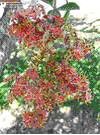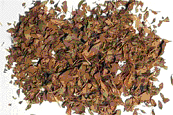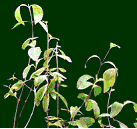Henna
| |
Egyptology Articles
Herbs and Aroma
Alternative
Medicine
Aroma Therapy
|
|
This fascinating plant is world wide known for the beautiful coloring dye that
is used by the Orientals in coloring their hands and body. The Egyptians are
said to have prepared both an oil and an ointment from the flowers for making
the limbs supple. Egyptian Royalty were said to dye their hair with Henna
leaves. Henna’s botanical name is Lawsonia Inermis,its common name is
Jamaica Mignonette, Mendee, Egyptian privet, smooth Lawsonia. Its Arabic name is
henna and the most popular Indian name is Mendhi.
The earliest civilizations that can be
proved to have used henna include the Babylonians, Assyrians, Sumerians,
Semites, Ugaritics and Canaanites.
The leaves of the henna plant
are the source of a red-brown dye widely used for body art, known as
mendhi in South Asia. First used in the Near East and South Asia, henna
art is now popular around the world.
There are numerous artifacts from Iraq, Palestine, Greece, Egypt, Crete
and Rome from 1400 BCE to 1AD that show women with henna patterns on their
hands. The early center of the use of henna as a woman's adornment seems to have
been in the eastern Mediterranean, where it grows wild. It was used by the
Canaanite women in pre-biblical times The Canaanites spread their traditions,
including the use of henna, across North Africa between 1700 and 600 BCE,
specifically establishing the Berber traditions of henna in Morocco.
Henna was used in Palestine from the earliest historical period, and there are
Roman records of henna being used by Jewish people living in Jerusalem during
the historical period of the birth of Christ.
|
 |
| |
Henna |
When Islam began in the 6-7th centuries AD, henna was incorporated into the
customs of Muslims from the western Middle Eastern women's henna traditions that
were widespread and long established. As Islam expanded quickly into other
countries, the use of henna went with it. All of the countries that were part of
the Islamic world have used henna at some time, most frequently as part of
wedding celebrations. Most of them continued to celebrate the "Night of the
Henna" and regard henna as a beautiful and suitable ornament for women until
present day.
Since 1890 it has been widely used in Europe for tinting the hair, usually in the form of a shampoo, many
shades being obtainable by mixing with the leaves of other plants, such as
indigo. As a dye for the skin or nails the powder may be mixed with lemon juice,
made into a paste with hot water, and spread on the part to be dyed, being
allowed to remain for one night.
The
parts used are the leaves that are dried and then crushed to form a dark green
powder. The flowers and also the fruit are also used.
Flowers are numerous, small, white or rose coloured and fragrant. The
plant lives scarcely in dry decidious forests, widely cultivated as a hedge
plant. It is mostly found in Egypt, India, Kurdistan, Iran, Syria.
It is widely cultivated in
tropical countries but probably native to North Africa and Asia. It is widely
naturalized in the West Indies and Mexico where it is known as "mignonette." Its
leaves produce the henna or alhenna of the Arabs (cyprus of the ancients), a
yellow die which is used in Egypt and
elsewhere by women to color their nails, and by men to die their beards, and for
other similar uses including horses manes and tails. It is known in the West
Indies as "Egyptian privet", and sometimes as "reseda".
The small, white and yellow, heavy, sweet-smelling flowers are borne on dwarf
shrubs 8 to 10 feet high and reaching a height of up to 6 meters, the plant has
fragrant white or rose-red flowers.
Henna is planted today primarily as an ornamental hedge, but is probably best
known for the dried, ground leaves traditionally used to produce colorfast
orange, red, and brown dyes.
The
constituents of Henna is found in it in a brown substance of a resinoid
fracture, having the chemical properties which characterize the tannins,
and therefore named hennotannic acid. Dried, powdered
leaves of henna contain about 0.5 to 1.5 percent lawsone, the chief
constituent responsible for the dyeing properties of the plant. Henna
also contains mannite, tannic acid,
2-hydroxy-1:4-naphthoquinone resin mucilage, gallic acid,
glucose, mannitol,fat, resin and mucilage are also present.The colouring
matter is the quinone .and napthaquinone.
USES
Medicinal Action and Uses
As a medicinal plant, henna has been used as an astringent, antihemorrhagic,
intestinal antineoplastic, cardio-inhibitory, hypotensive, and a sedative. It
has been employed both internally and locally in jaundice, leprosy, smallpox,
and affections of the skin. The fruit is thought to have emmenagogue properties.
It has also been used as a folk remedy against
amoebiasis, headache, jaundice,
ranging from beriberi to burns and
bruises ans leprosy.Henna extracts show
antibacterial, antifungal, and ultraviolet light screening activity. Henna has
exhibited antifertility activity in animals and may induce menstruation.
Henna has been used as medical treatment for wide range of ailments to cure
almost anything from headache to leprosy and other skin disorders. It is used to
create an instant ‘Scab’ on large areas & is believed to have antiseptic
properties. As a cooling agent it is used for burning of skin.
It also has great dandruff fighting ability.
Henna is also used for
rheumatic and arthritic pains. Alcoholic extract of the leaves showed mild anti-
bacterial activity against Staph aureus and E. coli'. Antibacterial and
antifungal activities have been confirmed .The antihaemorrhagic properties are
attributed to lawsone. The naphthoquinone has emmenogogue and oxytocic actions.
The dried leaf and petiole of henna are generally recognized as safe when used
as a color additive for hair. A distilled water prepared from them is used as a
cosmetic, and the powdered leaves have been in use from the most ancient times
in Eastern countries for dyeing the hair and the nails a reddish-yellow.
Traditionally henna is used to decorate hands and feet during weddings and other
ceremonies.
Henna features in the
Siddha system of medicine. Siddha
physicians consider parts of henna to be astringent, detergent, deodorant,
cooling and a sedative. Fresh leaves mixed with vinegar or lime juice are
bandaged onto the soles of the feet to treat 'burning feet', a symptom of
beriberi. Ground leaves are applied to sore joints to ease rheumatism. The juice
of the plant can be applied to the skin for headaches, and the oil is applied to
hair to prevent it from going grey.
Its flower oil relieves muscular pains, while its seeds are used as a deodorant
and to regulate menstruation. Henna flowers induce sleep, cure headaches and
bruises. Leprosy has been treated by henna bark, as well as by an extract of
leaves, flowers and shoots. The bark has also been used to treat symptoms of
jaundice and enlargement of the liver and spleen. It can be applied to the skin
to treat eczema, scabies, fungal infections and burns.
The Ayurvedic system uses the henna
leaves to treat vitiligo (pale patches on the skin where pigment is lost), and
the seeds are used to cure fever. Fruit oil is a folk remedy used in disorders
causing hardening of the liver and diaphragm, and an ointment made from young
fruit is used to prevent itching.
|
You may freely reprint this article
or place it on your website by
adding this statement: Courtesy of www.kingtutshop.com
|
_________________________________



